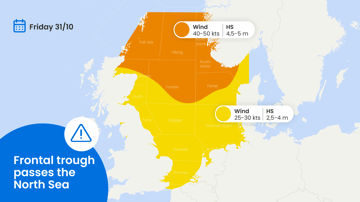The North Sea will be sandwiched between high pressure to the west and low pressure to the east this week. As a result, there will be significant differences between the western and eastern parts of the North Sea. The confidence in the forecast decreases toward the weekend. Read all about it in this week’s North Sea briefing.
A low pressure system over eastern Europe will reach Sweden today. It is expected to move counterclockwise into Denmark tomorrow, where it will linger until Friday. By then, a secondary low pressure area will move northwest from the Baltic States into Sweden, merging with the system over Denmark. Meanwhile, high pressure will remain centered over the Azores this week. A ridge associated with this high extends northeast across Scotland into the Norwegian Sea today. This ridge will weaken tomorrow as a weak frontal trough approaches from the northwest. The trough will cross the UK on Thursday and weaken over the North Sea by Friday.
Due to high pressure to the west and low pressure to the east, notable contrasts will develop across the North Sea this week. The highest wind speeds (22–30 knots) are expected over the shipping areas North Utsire, South Utsire, and Fisher on Tuesday, gradually shifting toward the German Bight on Wednesday. Significant wave heights in these areas will increase to 2.5–3.5 meters through Thursday morning. By late Thursday, wave heights will decrease again to below 2.0 meters. Meanwhile, the western part of the North Sea will remain considerably calmer. Wind speeds will generally range between 5–20 knots, with the lightest winds near the UK coast. Significant wave heights will initially range from 0.5 to 1.5 meters, gradually increasing to 1.0–2.0 meters on Wednesday. By Thursday, calmer conditions are expected across the entire North Sea as the low pressure over Denmark weakens and a weak trough approaches from the west. Wind speeds will decrease to 5–15 knots (still up to 20 knots in the German Bight), and wave heights are expected to fall to around 1.0–1.5 meters overall.
From Friday onwards, forecast confidence begins to decrease. Low pressure over Southern Scandinavia is expected to continue influencing the North Sea, while the Azores high gradually builds a new ridge extending over Ireland. However, there is still uncertainty regarding the extent to which the various shipping areas will be affected by the low pressure system.
Some weather models indicate that low pressure may move into Denmark again on Saturday. In this scenario, winds would increase to 20–30 knots across much of the Northern and Central North Sea from late Friday through early Sunday, with the strongest winds expected over the southern parts of Viking and the northern parts of Forties and Fisher on Saturday. Associated significant wave heights could reach 3.0–3.5 meters.
Other models suggest a different track, with the low moving counterclockwise across the central North Sea and into Germany via the German Bight during the weekend. This alternative scenario would bring winds of 20–27 knots and wave heights up to 2.5 meters across the western half of the North Sea. The eastern half, particularly Fisher and the German Bight, would remain calmer, with winds of 5–15 knots and wave heights around 1.0–1.5 meters.
This week begins with pronounced differences between the western and eastern North Sea and ends with increasing uncertainty regarding the position of low pressure systems. Please consult our latest weather forecasts for up-to-date information on wind and wave conditions at your specific location.
Stay updated on LinkedIn
We plan to post this weather briefing on our Infoplaza for Marine Weather Operations LinkedIn page as well. This is also the place where we will share other insightful marine weather articles, so be sure to follow us to never miss an update.




